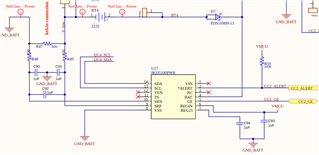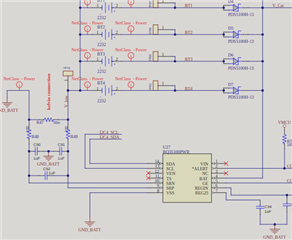- Ask a related questionWhat is a related question?A related question is a question created from another question. When the related question is created, it will be automatically linked to the original question.
Tool/software:
Dear TI,
We are using the BQ35100 for checking the EOS of battery. And we use the Saft LSH20 D 3.6V batteries four in parallel.
Below are the questions I have:
1. Do we need to configure the ChemID for the EOS mode, battery:(Li-SOCl2) chemistry? or not required to configure chemID.
2.Do we need to configure the calibration even in EOS mode ? If yes, how to get the CC Offset,board offset values?
3.Does the BQ35100 support the capcaity of the 52A, as we use the 4 batteries(Saft LSH20 13Ah) in parallel?
4.Below circuit we use in our schematic, Does the design is correct?
5. Whenever we do the the load pulse, do we need to apply the load 100mA? If yes, 500msec duration is okay?
6.What EOS parameters to be configured to get the EOS alert?
7.What sequence to be followed in the code for each load pulse?
8.Do you have any C code reference for EOS operation?
Thanks,
Chandra
Hello Chandra,
1. ChemID is not required for EOS mode.
2. Yes, the gauge should be calibrated so that the gauge reads accurate voltage and current values. I would recommend looking over section 3.2 of the TRM. https://www.ti.com/lit/ug/sluubh1c/sluubh1c.pdf
3. If you have an application greater than 32Ah then you will need to do some scaling on the gauge. I would recommend calibrating the current in half, this way you can reduce all capacity based parameters in half as well. For calibration I would highly recommend using BQStudio to do this.
4. C90, C91, C92, C93 should be changed to 0.1uF caps.
5. The load does not necessarily have to be 100mA. The load needs to cause at least a 100mV drop in open circuit voltage for your battery. Since the battery you are using has a very large capacity I suspect the pulsed load will need to be larger. Maybe 500mA? Some testing will need to be done to verify this. 500msec is perfectly fine.
6 & 7. In terms for register settings for EOS mode and test procedure I would recommend looking over this document: https://www.ti.com/lit/an/sluaal7/sluaal7.pdf
8. Sadly, we do not have C reference code for this. However, I can send this document about gauge communication that has some C sample code: https://www.ti.com/lit/an/slua801/slua801.pdf
Regards,
Adrian
Hi Adrian,
Thank you for the reply.
Please check below for continuation:
3.can you provide the details of calibrating the current in half? for bigger capacity.
4. We will change the capacitor values. Does the R47,R48,R49 values are okay?
New queries:
1. For testing the 4 batteries in parallel what is the best way to discharge the batteries and get the EOS alert with bq35100EVM-795 board?
2. instead of using the 4 batteries, can we use the single battery for testing and remaining batteries calculated based on the single battery test result?
3. When we are using the bq35100 evaluation board , what load to be applied between batt+ and pack-? does bq35100EVM-795 board trigger the load pulse automatically during the testing? if not, then we need to trigger from bqstudio with every 5hrs for load pulse?
4.What is EXTVCELL, series cell count? when they required to be configured. For EOS mode, do we need to set the design capacity?
5.https://www.ti.com/lit/an/sluaal7/sluaal7.pdf as part of this doc there is no calibration suggestion for EOS mode. But you recommend to do it?If yes, what are them to be calibrated.
6. In the below design we connect the battery voltage to IC pin4 after the diode(Vf 0.57V). Does that affect the reading of EOS alert?

Thanks,
Chandra
Hello Chandra,
3. It is easiest to use BQStudio to do this as the GUI will all the calculations in the background and update the data flash registers appropriately.
4. Yes, those resistor values are fine.
New Inquire:
1. You can use a battery tester or a power supply to discharge the battery for learning the internal resistance of the battery. For example, I use keithley power supplies
2. It is recommended to use 4 batteries if that is what the end application will use.
3. BQStudio does not trigger the load pulse. You will need to use a power supply. I would recommend an automated power supply that can be controlled with a script.
4. EXTVCELL is used if you have more than 1 cell in series. Yes, it is recommend to set the design capacity on the gauge
5. Yes, all gauges should be calibrated. Voltage, current and temperature should all be calibrated.
6. Yes, this configuration will affect the EOS data.
Regards,
Chandra